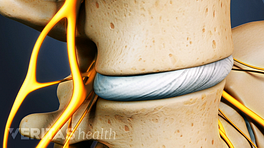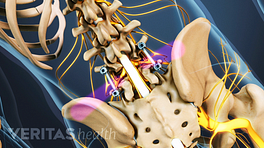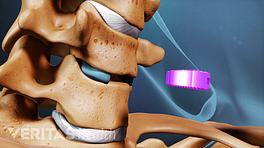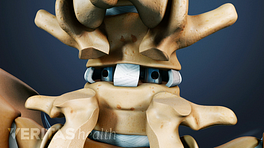If you plan to opt for spinal fusion surgery to treat your neck or lower back pain, your surgeon will likely place an interbody cage in your spine. The cage serves as a space holder between your affected vertebrae and allows bone to grow through it, eventually becoming a part of your spine.
The following points address the most common questions that people may have concerning the implant or cage being permanently inserted in their spine during spinal fusion.
Typical spinal cages
Interbody cages are placed between the bodies of 2 adjacent vertebrae—after removing the intervertebral disc that typically occupies this space. Spinal cages may be made of metal, polymer, ceramic, or a fusion of different materials. Two commonly used materials include titanium and polyetheretherketone (PEEK). 1 Jain S, Eltorai AE, Ruttiman R, Daniels AH. Advances in Spinal Interbody Cages. Orthop Surg. 2016;8(3):278–284. doi:10.1111/os.12264
The cages have a hollow center, which is filled with a bone-growth promoting material, such as beta‐tricalcium phosphate or your own bone (taken from your hip during the same surgery as the fusion).
See Interbody Cages for Spine Fusion
Potential benefits of spinal cages
Interbody cages aim to improve the stability and balance of the treated spinal segment, while also relieving pain and restoring function. The goals of spinal cages include 2 Alkalay RN, Adamson R, Groff MW. The effect of interbody fusion cage design on the stability of the instrumented spine in response to cyclic loading: an experimental study. The Spine Journal. 2018;18(10):1867-1876. doi:10.1016/j.spinee.2018.03.003 :
- Restoring the height provided by the original intervertebral disc
- Supporting the front (anterior) part of the spinal column
- Expanding the bony openings between the vertebrae (foramina), providing more space for spinal nerves
- Restoring the normal lordotic (S-shaped) curve of the lower (lumbar) spine
- Transferring loads from the upper segments to lower sections of the spine
- Promoting a solid fusing of the adjacent vertebral segments by promoting bone growth
- Increasing the spaces within the spinal canal to decrease the compression of neural tissue that may be indirectly compressed
Depending on the number of spinal segments being fused, your surgeon may place more than one cage in your spine.
Conditions treated with spinal cages
The most common conditions treated by spinal fusion surgery and cage placement include pain and loss of function caused by:
- Degenerative disc disease: A condition where the disc begins to degenerate and lose function.
- Spondylolisthesis: The slippage of one vertebra over the one below it.
- Spinal tumors or masses: Growth within the spinal tissues that may impinge into the spinal segment(s), disturbing the stability of the spine.
- Spinal stenosis: A condition that causes narrowing of the bony openings for spinal nerves.
- Herniated discs: A condition where the inner contents of the discs leak out.
Watch Herniated Disc Video
Revision surgeries of the lower back (due to failure of the previous surgery) and correction of spinal deformities, such as degenerative scoliosis or kyphosis may also require spinal fusion. 3 Omidi-Kashani F, Hasankhani EG, Ashjazadeh A. Lumbar spinal stenosis: who should be fused? An updated review. Asian Spine J. 2014;8(4):521–530. doi:10.4184/asj.2014.8.4.521
See Failed Back Surgery Syndrome (FBSS): What It Is and How to Avoid Pain after Surgery
Long-term outlook for spinal cages
Research suggests that 70% to 95% of cervical fusion 4 Ofluoglu AE, Erdogan U, Aydogan M, Cevik OM, Ofluoglu O. Anterior cervical fusion with interbody cage containing beta-tricalcium phosphate: Clinical and radiological results. Acta Orthopaedica et Traumatologica Turcica. 2017;51(3):197-200. doi:10.1016/j.aott.2017.03.001 and 88% of lumbar fusion 5 Baeesa SS, Medrano BG, Noriega DC. Long-Term Outcomes of Posterior Lumbar Interbody Fusion Using Stand-Alone Ray Threaded Cage for Degenerative Disk Disease: A 20-Year Follow-Up. Asian Spine J. 2016;10(6):1100–1105. doi:10.4184/asj.2016.10.6.1100 may be achieved when interbody cages are used. While the role of the spinal cage is a factor for achieving a solid bony fusion, the overall success of a fusion surgery depends on several parameters, such as but not limited to the skill of the surgeon and the integrity of the surrounding tissues.
Over time, some cages may undergo subsidence (caving in), which can compromise the fusion and stability of the treated spinal segment(s). Subsidence may occur due to poor bone quality, the structure and/or material of the cage, improper bone preparation prior to the cage placement, and other anatomical problems.
Newer designs allow spinal cages to be expandable—a small cage is implanted (reducing the risk of nerve injury), which expands to a larger size after the implantation is done. The surgeon can typically control the extent of expansion, to ensure that the surrounding nerves are not injured during the surgery.
It is important for you to talk to your surgeon about the types of materials that will be used in your spinal fusion surgery. Educate yourself on the types of interbody cages your surgeon may recommend and take the time to research them. When you are well-informed about the devices placed in your body, you will likely be less anxious and more satisfied with your surgical outcome.
Learn more:
- 1 Jain S, Eltorai AE, Ruttiman R, Daniels AH. Advances in Spinal Interbody Cages. Orthop Surg. 2016;8(3):278–284. doi:10.1111/os.12264
- 2 Alkalay RN, Adamson R, Groff MW. The effect of interbody fusion cage design on the stability of the instrumented spine in response to cyclic loading: an experimental study. The Spine Journal. 2018;18(10):1867-1876. doi:10.1016/j.spinee.2018.03.003
- 3 Omidi-Kashani F, Hasankhani EG, Ashjazadeh A. Lumbar spinal stenosis: who should be fused? An updated review. Asian Spine J. 2014;8(4):521–530. doi:10.4184/asj.2014.8.4.521
- 4 Ofluoglu AE, Erdogan U, Aydogan M, Cevik OM, Ofluoglu O. Anterior cervical fusion with interbody cage containing beta-tricalcium phosphate: Clinical and radiological results. Acta Orthopaedica et Traumatologica Turcica. 2017;51(3):197-200. doi:10.1016/j.aott.2017.03.001
- 5 Baeesa SS, Medrano BG, Noriega DC. Long-Term Outcomes of Posterior Lumbar Interbody Fusion Using Stand-Alone Ray Threaded Cage for Degenerative Disk Disease: A 20-Year Follow-Up. Asian Spine J. 2016;10(6):1100–1105. doi:10.4184/asj.2016.10.6.1100











